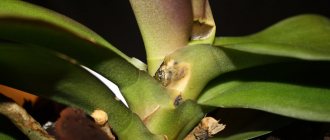Orchid genus catasetum (Catasetum) is represented by epiphytes. It unites approximately 150 plant species. They can be found in nature in South and Central America. Most often, such plants are found in Brazil.
This plant has a sympodial growth pattern. It has a shortened rhizome (creeping shoot), while it presses tightly to the ground, which is why young pseudobulbs grow almost closely pressed to the old ones. Clustered elongated oval pseudobulbs resemble wrinkled green cigars that have pointed ends. In species that are quite large in size, mature pseudobulbs reach 20 centimeters in height and 7 centimeters in diameter. Young pseudobulbs that are not yet 1 year old are leafy, while adults are completely naked. There are many vaginal leaves, usually from 3 to 7 pairs. The part located at the bottom of the sheet plate is film, and it acts as a wrapper. So, after the leaf dies and dries, this tissue remains on the surface of the pseudobulb, and it prevents the accumulated moisture from evaporating too quickly. Thin leathery leaves have a pointed oval shape with clearly visible longitudinal veins. They reach a length of 20 to 30 centimeters.
This genus of orchids stands out among others in that it has pronounced sexual dimorphism of flowers. Flowers that are male are larger in size (diameter from 10 to 12 centimeters), they are complex and richly colored, and there are much more of them on the peduncle. The female flowers are not as large and they have a relatively simple appearance. A large number of species have resupinated male florets (turned upside down), and a large lip, folded into a funnel or shaped like a bent cup, hangs over the flower. The fleshy petals (petals) and sepals (sepalia) are oval or lanceolate in shape. The elongated column has several stamens. All female flowers are “regular”; their lip has the shape of a helmet, while the column is not as long and thin as that of the male flower.
Caring for the catasetum orchid at home
Most types of such orchids are recommended to be grown in an orchidarium or greenhouse. And there are also species that are not able to grow in indoor conditions at all; if they find themselves in an unfamiliar environment, they die very quickly.
Temperature
Such a plant needs a warm temperature regime, and it is necessary to ensure a difference in daily temperatures. Thus, the catasetum will grow and develop normally at a daytime temperature of 29–32 degrees, and a nighttime temperature of 21–24 degrees.
If desired, this flower can be moved outside. He can stay there from mid-May to mid-September. A garden or balcony is perfect for this. In this case, the necessary difference in daily temperatures will be natural.
Illumination
The flower needs bright lighting throughout the year, but it must be diffused. Experienced gardeners recommend placing such an orchid under powerful phytolamps, thus replacing natural lighting with artificial lighting. Daylight hours should be 10 hours long.
Plants with leafy pseudobulbs, as well as those with blooming flowers, when kept outdoors, should be placed in places protected from direct sunlight. The fact is that burns may appear on flowers, as well as on delicate foliage. However, it should be noted that placing the catasetum in a too shaded place is not recommended.
Earth mixture
Blocks and pots are used for growing. To fill the pot, a substrate is used, consisting of pieces of coarse pine bark, a small amount of sphagnum and charcoal.
A large piece of pine bark is most often used as a block. The roots and rhizome of the plant are securely fixed on its surface, and they are first wrapped in a not very thick layer of moss.
How to water
It is worth remembering that the bark must dry thoroughly between waterings. It is recommended to water this flower not in the usual way, but by immersing a block or pot in a basin filled with water. You should wait until the bark and root system are saturated with liquid, and then remove the flower from the water. When excess liquid has drained, the catasetum should be returned to its usual place.
In order to stimulate flowering, orchidists with considerable experience advise giving the plant a “hot shower” along with watering, or immersing the flower completely under water, which should be preheated to 35 degrees.
Humidity
This plant reacts extremely negatively to low air humidity. The optimal humidity for this flower is 70–80 percent. In order to increase humidity to the required level, you need to use household humidifiers or steam generators. If the catasetum is grown in an orchidarium, then it should be remembered that stagnant damp air can cause fungal diseases. In this regard, systematic ventilation is recommended for prevention purposes.
Rest period
The dormant period for this orchid begins in mid-November. The fact is that at this time, a cool and dry period begins in the places where she comes from. The air temperature during this period should be from 18 to 20 degrees, while watering should be stopped completely, but the illumination should be left at the same level. If the pseudobulbs wrinkle very much, then to maintain them in a healthy state, you should systematically spray the substrate, but only lightly. Watering begins fully after young pseudobulbs appear, as well as the first roots.
If you abandon the dormant period, the plant will bloom very sparingly, and after a while the flowering may stop altogether.
Features of transplantation
Transplantation is carried out once a year. The fact is that during the dormant period, some roots of the catasetum die off, which not only contaminate the substrate, but also cause the appearance of various fungi and bacteria. It is necessary to replant at the beginning of the growing season, at a time when young pseudobulbs are actively growing new roots.
Fertilizer
Feed once a week. To do this, use a special complex fertilizer for orchids, and the dosage should be checked on the packaging. Fertilizer is usually dissolved in water for moistening from a sprayer or watering.
During the dormant period, the flower is not fertilized.
Reproduction methods
When grown indoors, catasetum can be propagated by dividing its rhizome, which should be overgrown, into parts. It should be remembered that each division must have at least 3 mature pseudobulbs.
In industrial conditions, this plant is propagated by seeds and meristem.
Pests and diseases
Spider mites often settle on young leaves. If such a pest is detected, the flower should be given a warm (about 45 degrees) shower, and the leaves should be thoroughly washed. If there is such a need, the procedure must be repeated.
If the catasetum is not provided with optimal conditions, it may stop flowering, the growth of new pseudobulbs, and in some cases it may even die.
General information
Orchid perfume factory: overview of different types, descriptions and photos of varieties
The plant has sympoidal progress. The rhizome is short, it presses very closely to the ground due to the fact that the pseudobulbs grow closely pressed to each other.
Long-ovular pseudobulbs resemble wrinkled green cigars with absolutely pointed ends. Large plants have pseudobulb bulbs 20 centimeters long and 7 cm in diameter.
New pseudohybris, which are even less than 1 year old, are quite elongated, and adults are completely naked.
There are many sheets in the vagina, from 3 to 7 pairs. After the leaves die and dry out, this tissue remains and prevents moisture from quickly evaporating. The leather sheets have a pointed oval shape with a longitudinal longitudinal vein. Their length ranges from 20 to 30 centimeters.
This genus differs from others in that it is expressed in sexual dimorphism of flowers. Male flowers are not small in size, there are more of them on the stalk, and they have a rich color. The female flowers are small, with a simple appearance.
Many types of flowers float to the surface, the lip is large, wrapped in a funnel or cup shape located above the flower. Thick petals and sepals are oval or lanceolate.
The column contains a number of stamens. The lip of a woman's flower helmet is not as long and thin as a man's lip.
Caring for catasetum orchids at home
Almost all species of this beautiful orchid should be grown in an orchidarium or greenhouse. But there are quite fancy species that cannot be grown at home, and they quickly die due to an unusual, unsuitable environment.
Temperature
The plant needs a fairly warm regime with a noticeable daily temperature difference. The suitable temperature for katasema is 29-32 degrees all day and 21-24 degrees at night.
Also, if you really want, you can transplant this flower outside. The period should last from mid-May to mid-September. It can be easily planted in the garden or on the balcony. In such cases, the temperature difference is natural and does not require external intervention.
Light
The flower needs bright light all year round, but it must be sufficiently diffused. Professional gardeners recommend installing the plant under phytolamps, replacing sunlight with artificial light. Daylight hours should last approximately 10 hours.
Orchids with pseudobulbs or blooming flowers should be placed in the shade when stored outside the house. Strong lighting can cause burns on flowers and leaves. However, the orchid should not be placed in strong shade protection.
Land for catasetum
Pots or blocks are used for growing. Fill the container with pine bark backing, some peat moss and charcoal.
Pine bark is used as a place for the block. On the outside, they strengthen the roots and rhizomes by wrapping them in a thin layer of moss.
Irrigation
The plant is not suitable for low humidity. The best air humidity is 70-80%. Humidifiers or steam generators should be used to increase humidity.
When growing katasema in an orchidarium, you need to know that damp air causes a disgusting fungus. Ventilation is recommended to prevent this.
Rest
The rest period begins around mid-September. Due to the cool and dry period in orchids.
Stop watering and maintain the temperature between 18 and 20 degrees Celsius, but the lighting should be stopped.
If there are a large number of wrinkles, pseudobulb should be sprayed onto the substrate systematically, but not too heavily. Watering should be done when new pseudobulbs and the very first young roots appear.
Without a rest period, the plant will be too poor in flowering or may even stop blooming luxuriously.
Transfer
Requires constant transplantation once every year. Depending on the dosage outside the package, use special fertilizers for orchids. Fertilizers are thoroughly mixed in water and sprayed or watered.
propagation of catasetum at home
For propagation, the rhizomes grew into pieces. There should be at least 3 fairly mature pseudobulbs on the site.
In the industry, orchids are propagated by meristem and with seeds.
Video review
The subtribe Catasetumaceae includes several genera, including many species and hybrids, including the luxurious black orchid Fredclarkeara, created by the famous American orchid breeder Fred Clark. Katasetum, as the most numerous of them, gave its name to the entire group.
Carrot orchids are popular among gardeners precisely because of their unusual nature, which is associated with a pronounced seasonality in their development. Bright colors, pleasant aroma, unusual flower shapes, completely different flowering on one plant, colorful pseudobulbs - all together create an incredible aura of exoticism and mystery around carrot orchids, attracting more and more people who want to place these wonderful orchids in their apartments.
Carrots have different structures, sizes and flower shapes, but the structural features of the entire plant are the same. The most distinctive feature is the shape of the pseudobulb, which resembles a spindle or a well-known root vegetable, although to the inhabitants of the American continent it looks like a pointed cigar.
Biological properties of carrot orchids
All representatives of the Catasetum group are epiphytic plants that live on the branches and trunks of trees of plains and plateaus in conditions ranging from tropical to temperate continental. They grow in height from 10 cm to 60–70 cm and belong to deciduous orchids with a clearly defined dormant period. Peduncles appear either in the spring immediately after rest, or in the summer or early autumn. In spring-flowering species, they are formed from a bud at the bottom of the pseudobulb, in summer- and autumn-flowering species - from the axil of leaves, bearing single flowers or inflorescences consisting of several dozen fragrant flowers from 2 to 20 cm in diameter. Their color palette is varied - from white to cherry-purple and even soft light green.
Most catasetums have developed so-called flower dimorphism, when on the same plant peduncles are formed with either male or female flowers, and sometimes both at the same time, or even bisexual. Some orchid growers with experience in growing catasetums manage to achieve the flowering of larger and brighter male flowers using simple care tricks, and if they are lucky, they simultaneously get peduncles with different colors on the same plant.
This is interesting
The catasetum orchid is seriously called the shooting orchid. As soon as a pollinating insect touches the special bristles inside the male flower, the plant immediately catapults the pollinia into a troublemaker. It also goes to those who decide to smell the wonderful aroma.
To understand how to care for carrot orchids at home, it is important to understand the cyclical nature of their development.
Life cycles of catasetum orchids
In early spring, catasetums begin the growing season, growing new roots on the pseudobulbs, since their old ones, as a rule, die off. However, watering after a dry dormant period begins only after new roots have reached at least 7.5–12.5 cm - this is what experienced foreign catasetum breeders advise.
Over the next 3–4 months, the carrot orchid actively develops new pseudobulbs and foliage, almost doubling in size. During this period, the plants are intensively watered and fertilized; with proper care, flower stalks are formed and blooms of amazing beauty.
The next cycle is preparation for the dormant period, which occurs at the end of autumn. At this time, the foliage of the carrots begins to turn yellow and fall off.
Advice! By mid-November, it is necessary to completely stop feeding catasetum orchids and reduce watering by half.
Finally, the dormant period in carrots is due to the completion of the formation of a new pseudobulb, as well as a short day length, cooler day and night temperatures, and the accumulation of moisture and nutrients in the pseudobulb. Many ochie growers remove the plants from the substrate and store them until spring in a dry box left in a cool room; some leave them in pots. Pseudobulbs are sprayed only once in case of severe wrinkling.
Advice! It is advisable to completely stop watering the carrot orchid before January 1st.
Creating an appropriate microclimate
The best place for Katasetum to grow is in windows with eastern and southeastern exposure. On the south side the plant should be slightly shaded from direct sunlight, and on the north side it should be illuminated with a phytolamp.
Catasetum is a very heat-loving plant that requires compliance with the temperature regime with a pronounced difference between day and night temperatures.
| Growing season | Recommended ambient temperature range, °C | |
| During the day | At night | |
| Active growth of vegetative mass, forcing of peduncles and flowering (March-October) | 29-30 | 21-24 |
| Rest period (November-February) | 20-24 | 18-20 |
To feed Katasetum, use mineral fertilizers specially designed for orchids, dissolving them in water for irrigation according to the instructions.
During the period of intensive growth of the orchid, you can apply fertilizers with a high nitrogen content. For example, the N-P-K content is 30-10-10, respectively. But after the pseudobulbs are fully formed, the frequency and volume of fertilizing should be reduced. At this time, to maintain flowering, it is better to use a fertilizer with a ratio of nutrients in favor of phosphorus and potassium, say 10-30-20.
Doctor of Biological Sciences, TV presenter Oktyabrina Ganichkina.
Care and cultivation of catasetum group orchids
Orchid growers with experience in growing carrots claim that caring for them is not much different from the same phalaenopsis.
Planting carrots
Catasetum can be grown in both plastic and ceramic pots. In a transparent container, the condition of the roots and especially their length are better visible, which is important for determining the start of watering after a dormant period. They are often kept in hanging baskets or flower pots.
If the carrots were resting in a box, when buds appear at the base of the pseudobulbs, they are fixed vertically above the pot so that new roots penetrate the substrate and contribute to the stable position of the plant.
The mixture for growing catasetums is simple in composition. Usually they use pine bark, preferably pine, and sphagnum moss in equal quantities, and expanded clay as drainage. American orchid growers also offer the following substrate components: coconut chips - 3 parts and medium perlite - 1 part. It is advisable to plant small carrots in a pot filled 2/3 with New Zealand sphagnum moss, and 1/3 with polystyrene foam granules.
Placement in the house, lighting and temperature
Catasetums love a lot of light, so they are placed near large windows facing east or south, shading them from the scorching sun. Good air ventilation is extremely important; in summer, carrots are taken out into the fresh air, but protected from the sun and precipitation.
The temperature preferences of carrots depend on the type, mostly high - within 28-30 degrees in the summer, dropping to 21-24 degrees at night. In winter, during dormancy, the temperature should not fall below 18–20 degrees.
Interesting! The lighting of the catasetum determines what flowers will bloom on it: in moderate shade - male, in brighter light - female.
Watering and air humidity
Moisturizing carrots begins at the end of the rest period after the roots reach a certain length. Only bottom watering is allowed; you cannot pour water under the base of the pseudobulb - its bottom is extremely vulnerable to rot. Water should not get into the new growth; therefore, the required optimal air humidity of 70% is maintained by special devices or by placing vessels with water next to the orchid, but not by spraying.
The frequency of watering, depending on the microclimate, varies from 2 to 3 times a week. It is advisable to moisten by immersion, but not the entire pot, but about half or no more than 2/3 of its height.
Feeding
Fertilization of carrots begins with the resumption of watering. Use mineral fertilizers for orchids, add them to warm water prepared for immersion, alternate with clean water. Orchids also respond well to organic matter during the active growing season, when they form a new pseudobulb.
Propagation of carrots
Plants of the catasetum group are propagated by division of the rhizome. It is carried out with a sterile instrument until new growth and new roots begin to appear. Unlike other orchids, carrots develop well with two pseudobulbs, so plants containing 4–5 of them must be divided. If this is not done in time, the plant will draw out all reserves from the old pseudobulb, and it will die, and growth buds will awaken in the separated parts, and their roots will replenish the necessary reserves of nutrients.
Diseases and pests
The most dangerous thing for carrots is overwatering of any part of the plant, which can lead to the formation of putrefactive spots; the base of the pseudobulb is especially sensitive to overwatering.
Regarding insects, catasetums often suffer from invasions of spider mites and flat beetles. The former look yellowish or red-brown in appearance, and their larvae are greenish-yellow or reddish. The latter are distinguished by flat brick-red bodies separated by transverse seams with a mesh pattern, and the larvae are bright red. Experienced orchid growers advise novice carrot owners:
- weekly inspect the lower part of the leaves, where the silver web usually appears;
- effective protection against insects - a regular flea collar for cats, which is cut into pieces and attached directly to the pseudobulb;
- extensively affected areas are treated with acaricides that are less toxic for residential conditions - fitoverm, actofite, vermitek and others.
Photo from the Internet
Landing, transplant
Katasetum requires annual replacement of the substrate. The peculiarity of the orchid is that its waste products actively decompose the soil mixture. As a result, it loses useful substances and becomes very dense. As a result, food becomes unavailable to the plant. Water stagnates in the compacted soil mixture, and pathogenic microorganisms that cause diseases quickly multiply.
When moving to a new place of residence, you need:
A flower pot that is 5–8 cm larger in diameter than the previous container. It is better to choose transparent dishes, then it is easier to monitor the condition of the roots.
Before planting, carefully examine the plant and remove all damaged parts.
Soil mixtures for orchids from foreign manufacturers contain Pinian pine bark and coconut chips.
Genera of the catasetum group called carrots
Catasetum is a genus of approximately 80–120 species of epiphytic orchids with elongated oval pseudobulbs and leathery, elliptical-pointed leaves 20–30 cm long with distinct longitudinal veins. The main distinguishing feature of the plant is the pronounced sexual dimorphism of the flowers. Male flowers are larger and more beautiful than female flowers, appearing upside down - a cupped lip hangs over the fleshy petals. The female flowers are arranged “correctly”, with a helmet-shaped lip located below the petals. The color palette is different - from white to cherry-chocolate.
Catasetum
Clowesia (Clowesia) - consists of only 7 species, formerly included in the genus Catasetum. It is distinguished by small carrots 3–7 cm in size and numerous lush inflorescences on drooping peduncles, as well as relative resistance to rot in comparison with other plants of the catasetum group. The flowers are fragrant, ranging in color from snow-white to creamy-greenish, the petals are dotted with longitudinal narrow stripes of a darker tone.
Clowesia
Cycnoches - the flowers of this genus of orchids, which include up to 30 species, are often called the “swan orchid” due to their thin curved column. Peduncles are erect or curved, bearing inflorescences of 30 or more fragrant flowers. Like catasetum, male, female and bisexual flowers can bloom, and in some species all on the same plant.
Cycnoches
Mormodes - according to various sources, the genus consists of 70–80 species of epiphytic orchids that live in nature on the trunks of dying trees. The pseudobulbs of some species are gigantic - more than 70 cm, but there are also dwarf ones - no longer than 10 cm, in all species they are closely pressed to each other due to the short rhizome. The leaves are oval-pointed in a rich green hue. The peduncle does not grow from the top of the pseudobulb, but from its lower or middle part. Flowers come in a variety of colors - from pale yellow and orange to bright red and even greenish with all sorts of spotted and striped patterns. The shape of the flower resembles the profile of some fantastic creature, which is why mormodes is often called the “goblin orchid” by the people.
Mormodes
Dressleria - unlike other carrots, does not have a dormant period. The genus includes 10 species growing in humid forests at levels from 400 to 1500 m above sea level. Plants of this genus do not tolerate drying out. If they are grown in the same way as catasetums, they die. The peduncle appears from the base of the pseudobulb and bears a racemose inflorescence of 10–20 white or cream flowers.
Galeandra - includes 39 species native to South America, growing in Guyana, Venezuela and Brazil. Deciduous epiphyte from 40 to 75 cm tall. The leaves are lanceolate, the peduncle is curved, holding a racemose inflorescence of large (up to 6–10 cm in circumference) flowers with greenish-chocolate petals and sepals and a large lip, rolled into a tube and ending in an inverted ruffle. On the opposite side, the corolla tapers into a long spur. The lip is white with dark crimson longitudinal stripes, pink or purple. Blooms in summer.
Galeandra
Cyanaeorchis - includes 3 species of endemic epiphytes from Brazil, Argentina and Paraguay.
Grobya - consists of 5 species of epiphytes, endemic to the Brazilian plateaus, growing in tropical rainforests at altitudes from 2500 to 4500 m above sea level. Inflorescences on curved peduncles develop up to 20 or more spotted greenish-yellow flowers, smelling of honey, with a characteristic “hood”.
Grobya
Male and female flowers
The flower inflorescence consists of very fleshy buds. Unlike most other Orchids, these plants produce unisexual flowers , and they are located on different plants. The male flower is brightly colored, while the female flower is less noticeable and has yellowish-green hues.
Beautiful colorful flower buds
The conditions in which you grow this Orchid will determine what flowers will appear on the plant. Catasetum growing in intermediate conditions can produce both male and female flowers, but this is very rare. In this case, the buds will differ not only in size, but also in color! Such a plant can easily be confused with other species: even Orchid experts initially classified Katasetum as a different species.
Interesting fact
After the insect touches the bristles of the male bud, the flower shoots a pollinium at it . The same thing happens when you try to smell the aroma of a plant closer.
Apthenia cordifolia
The most common in our area is creeping heart-leaved apthenia. Its decorative effect makes the plant very expressive in hanging flowerpots. The stems of the plant, like thin hoses, hang 25-30 centimeters.
The leaves of this species are small, only about one and a half centimeters long. They are placed oppositely on the stem and have an inverted ovoid shape.
Aptenia blooms are small, deep pink and even scarlet. The flowers emerge from the axils of the leaves in the morning, are open all day, and die towards nightfall. The flower is no more than one and a half centimeters wide.
Breeders have developed a hybrid form of flower in different shades of red. And the color of the leaves is formed from transitions of various shades - from greenish to brown.
Such hybrids, obtained by crossing different species, are very demanding on soils. They develop best in light, aero- and water-permeable soils.
Once flowering is completed, this insect-pollinated plant forms an angiosperm fruit capsule of four nests. Tiny poppies do not exceed 1 centimeter in length. It is not strange that its small seeds spill out into dust from the cocoon and multiply quite easily. Moreover, even fresh, just collected seeds germinate.
There are many subspecies of this popular aizoon plant. Aptenia grows in the dry part of Africa, although it is also found in other regions.
There are many other types of apthenia. But they are less popular in our area due to their inability to cope with the climate.
Watering
Watering is an integral part of caring for any Orchid, but in our case the degree of development of the pseudobulbs will depend on it. During the relatively short growing season, the flower must retain a sufficient amount of moisture. While new leaves are growing, it is necessary to water Katasetum well . But after the pseudobulbs ripen, the frequency of watering should be reduced.
Once the leaves begin to turn yellow and fall off, you need to stop watering until new growth appears. But if the pseudobulbs begin to dry out and wrinkle too much , you can give them a little moisture.
Top dressing
In order for the flower to grow healthy and have strong pseudobulbs, it is necessary to add nutrients . During the growing season, you can use a high nitrogen fertilizer (such as 30-10-10). But after the pseudobulbs have formed, you need to reduce the frequency of fertilizing.
This is what a flower baby looks like
A fertilizer that supports flowering (such as 10-30-20) can be used in the fall or spring (depending on when your Orchid usually blooms). Don't forget, it's best to regularly feed the flower using a weak fertilizer solution.
The main causes of unpleasant odor
Before choosing a method to get rid of the stench, you need to determine its source in the house. The causes of an unpleasant odor may be:
- dead pest located in a hard-to-reach place;
- the smell of mouse excrement, which contains ammonia;
- leftover food hidden by rodents in their hiding places.
First you need to get rid of the original source of the problem - mice. The most effective method of eliminating pests in an apartment or any other room is to get a cat. After a predator appears in the house, the rodents soon leave the home. Very often, owners take their cat with them in order to get rid of mice in the countryside. But this method is not acceptable for everyone. Others can be used:
- – affects animals with ultrasound, thereby giving them unpleasant sensations;
- use folk remedies - peppermint oil, potassium permanganate, tar, vinegar;
- mechanical traps - mousetraps;
- , poisonous baits and preparations.
Substrate
The composition of the soil for planting Katasetum depends on the size of the pot. Small pots use a fine substrate, while large pots use medium potting mixes. Many enthusiasts who grow these Orchids at home use sphagnum moss.
But some species of Catasetum grow best on a piece of wood or a slab of cork, just as they grow in the wild. These flowers will require more frequent watering.
We recommend watching a short video about caring for the Katasetum Orchid:
Temperature
For the formation of peduncles and the formation of flower buds, Catasetum needs a difference in day and night heat. It is at least seven degrees.
The difference must be ensured at any time of the year. The ideal option is if, regardless of the season, the daytime temperature is +29 – +32. At night, the readings should drop to +22 – +25. Most often, such an environment is created in industrial greenhouses. But, thanks to modern household appliances such as “Climate Control”, you can now adjust any desired indicators at home.
From mid-autumn and winter, the temperature can be reduced to an average of +22 if there is no flowering. But you can’t allow it to drop, it’s colder than +18. This is the thermal limit for this orchid.
In summer, catasetum feels quite comfortable on an open balcony or garden if there are no drafts. The plant must be protected from turbulence. A sharp change in air masses has a detrimental effect. But air stagnation is also undesirable. The orchid needs good aeration.











